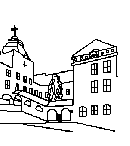
Computational Vision and Active Visual Perception, CVAP
As an example we here mention the project which studies active
computer vision and develops both techniques and algorithms
embodying such theories. The group has built an advanced
binocular head-eye system. It imitates the human eye and head
movements with similar performance with respect to speed and
gaze direction control.
(More.)
Interaction and Presentation Laboratory, IPLab
IPLab is an interdisciplinary group with researchers from computer
science, linguistics, psychology and sociology. It focuses on
human-computer interaction aspects of design and use of graphic
workstation applications. Among problems studied are support systems
for the writing process and aids in composing long and complex texts
without requirements to print large numbers of drafts.
(More.)
Studies in Artificial Neural Systems, SANS
The primary activity is research in the areas of neural modelling and
computation. Projects include fundamental studies in the principles
for artificial neural systems and development of design principles for
neurocomputing applications, development of simulation tools for
realistic simulations of neural locomotor systems and design studies
leading to the construction of a walking robot.
(More.)
Theory in computer science
The group currently works with computer algebra, graph algorithms and
logic on graphs, algorithms for processing natural language texts,
cryptography and complexity theory, like circuit complexity and
approximation complexity.
(More.)
Other research
Research in Numerical Analysis, NA and C2M2
The research is concerned with the development and analysis of
numerical methods for differential equations. The applications come
mostly from continuum mechanics. As an example we use parallel
computers to study the vibrations induced in the ground by dynamic
loads on the surface.
(More?.)
Center for Parallel Computers, PDC
PDC is an interdisciplinary organization. The goal is to stimulate
research and spread information on the use of parallel computers. This
is achieved by providing high-performance parallel computers and
expertise on their use to the technical and scientific computing
community in Sweden. The aim is to reach professionals from academia
and industry who have large and compute-intensive applications.
(More..)
Education
The department is responsible for the training in Computer Science and
Numerical Analysis in Stockholm and offers around 75 different
courses.
NADA gives numerous courses for ten of the eleven schools at KTH and also courses for continuing education.
The university courses are given in the programs in computer science, mathematics and physics and a number of special courses. The comprehensive programs are rounded off by a Master thesis requiring about three months' work. Around 50 undergraduates at KTH and 10 from the university programs complete their theses at NADA annually and about half of them are written in English. Most projects are carried out in the industry and a few at the department, all supervised by our teachers.
Computer resources and their maintenance
The main computing resource at NADA is a network of Apple Macintoshes
and Sun Microsystems workstations and servers. NADA has 550 network
nodes and serves around 4000 users. The system administration group of
around ten persons headed by Anders Hillbo takes care of all the
computing facilities.
Managing and distributing the file systems to all computers is one of the main challenges in a system of this size. The overall goal of the system administration of the computing resources at NADA has been integration, i.e. providing a homogeneous environment on a heterogeneous set of computer architectures. Further, the different activities at NADA put widely differing demands on the types of resources and services that have to be provided; activities range from educational computing with very high demands on reliability and documentation to experimental work in multimedia or high performance computing.
The system administration group produces a series of documentation on the computing resources, e.g. booklets on the editor Emacs and the operating system UNIX. The documentation is used in the undergraduate education.
As a result of the competence acquired from developing and building up
our own environment with its network the NADA system administrators
are also active outside the department.
(More.)
The KTHNOC group
KTH has since 1988/89 had the task given by the University Chancellors
Office to develop and run the Swedish academic computer network,
SUNET. The SUNET Group has been very successful in building reliable
academic networks. With gradually added responsibilities, it has grown
into an internationally renowned Network Operations Center, now called
KTHNOC.
The KTHNOC Group, headed by Björn Eriksen, runs the central nodes for SUNET, NORDUnet, and EBONE. The first two are multiprotocol computer networks supporting the protocols TCP/IP, DECnet, NJE (EARN/BITNET) and also have a connection to Datapak (X.25). The most successful of these standards is the TCP/IP-family, which has led to the development of an European IP-backbone network, called EBONE. Bernhard Stockman of KTHNOC has laid the groundwork for the formation of EBONE.
The group of eight members was transferred from the Administrative Computing Center to NADA in July 1992, as their task is closer related to research and development than to administration. They are "well connected" and contribute considerably to the development of International, European, Nordic and Swedish computer networking as part of Internet. (More about SUNET.)